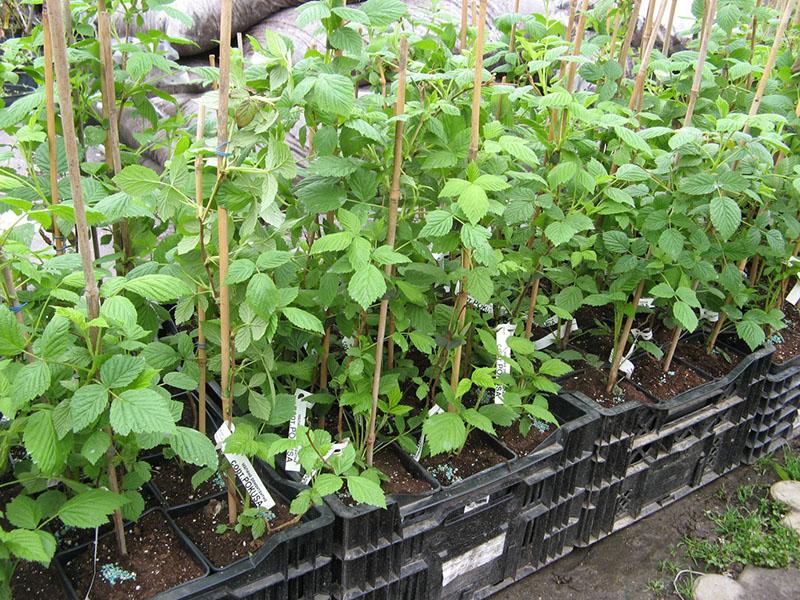When and how is raspberry planting carried out in the fall
 Planting raspberries in the fall among gardeners is considered the best option, which gives good rooting results and a quick onset of fruiting. Since the culture very quickly enters the growing season in spring, there is a risk of not having time to plant young seedlings on time. Plus, planting in the fall guarantees the first harvest next summer.
Planting raspberries in the fall among gardeners is considered the best option, which gives good rooting results and a quick onset of fruiting. Since the culture very quickly enters the growing season in spring, there is a risk of not having time to plant young seedlings on time. Plus, planting in the fall guarantees the first harvest next summer.
The best time to plant

The most favorable time for gardeners is the period from the second decade of September to the end of October.
The difference in the time of autumn work in the regions
 Autumn planting of raspberries is especially suitable for plots located in the southern regions of Russia, in Moldova, Ukraine. Autumn is long and warm there; the first cold weather comes in November. Thanks to this, the seedlings have time to grow roots, strengthen and do not freeze out during the first frosts.
Autumn planting of raspberries is especially suitable for plots located in the southern regions of Russia, in Moldova, Ukraine. Autumn is long and warm there; the first cold weather comes in November. Thanks to this, the seedlings have time to grow roots, strengthen and do not freeze out during the first frosts.
Spring comes early in warm regions. It is characterized not only by transience, but also by rapid warming, sufficient sun and moderate humidity. Under such conditions, the buds on raspberries quickly wake up and grow.
For this reason, on the plants planted in spring, leaf blooming occurs before rooting, as a result of which the culture does not have time to take root and dies.
In the northern regions, such as Siberia and the Urals, on the contrary: autumn is fleeting, and spring is wet and long. Therefore, summer residents prefer the spring method of cultivating sweet berries. Summer rooting is also possible if the temperature is not too high.
If the planting of raspberries in August coincided with the onset of rainy September, then the young have time to get accustomed to the first frosts.
The better planting raspberries in autumn
The autumn breeding method is approved by summer residents for small plantings and agronomists of farms due to the following indicators:
- About 90% of fall seedlings tolerate winter and grow well with the onset of the warm season. Due to humidity and moderate temperatures in September-October, they have a developed root system.
- Planting in the fall saves the gardener's time in the spring, when every day counts.
- Autumn seedlings begin to bear fruit faster than spring ones.
- It is easier to prepare soil for planting bushes in September than in March (it is moderately moist, it is easier to dig up and fertilize it).
- The variety of varietal planting material in the fall is larger and more affordable.
During the summer season, many summer residents look after their favorite berry bushes from friends, neighbors, and friends. Over the summer, they manage to evaluate the taste, size and amount of fruiting per season, as well as agree on receiving planting material in the fall. This method allows you to plant on the site exactly the culture that suits all indicators.
How to plant raspberries in the fall

To understand when and how to plant raspberries, it is recommended to pay attention to several key points:
- choosing a suitable place (with favorable lighting and humidification conditions);
- method of obtaining planting material (from your own garden, in a nursery, from friends, on the collective farm market);
- acceptable planting technique (in trenches or holes);
- time (a fine day about a month and a half before the first frost).

As inventory, standard summer cottage tools are required:
- household gloves;
- bayonet shovel;
- manual secateurs;
- watering can;
- pegs with a marking cord;
- fertilizers (humus, ash, granular mineral fertilizers).
If the planting material has already been purchased, but the place is not prepared, or the weather does not allow planting young plants on the day of purchase, then the seedlings are added dropwise.
That is, they dig one hole for all the plants, water it, put the raspberries in the hole with the roots and sprinkle them loosely with soil. This method allows you to keep the roots in good condition for a long time. It is important to ensure that the soil does not dry out too much.
Seat selection
 Despite the fact that the shrub is unpretentious, it is not ready to grow violently and bear fruit abundantly everywhere. A properly selected area will allow you to grow berries for up to 10 years in one place, getting a rich harvest.
Despite the fact that the shrub is unpretentious, it is not ready to grow violently and bear fruit abundantly everywhere. A properly selected area will allow you to grow berries for up to 10 years in one place, getting a rich harvest.
What is important to consider:
- Lighting. The plant prefers well-lit areas. In the shade, the bushes become smaller, later bloom, give a weak harvest.
- Remoteness of groundwater. For growth and ripening, fruits require moderate soil moisture. Stagnation of water in the root zone due to the close occurrence of groundwater is detrimental to the plant.
- Lack of drafts. Bushes are often planted along the fence, the walls of the building. This is due to the need to protect the culture from sudden gusts of wind and drafts.
- Soil composition. In order for the number and size of berries to please, it is advisable to plant raspberries in loose, nutritious soil (a mixture of leafy, turfy soil, humus, sand and fertilizers). If there is a possibility of flooding of the plantation, then a drainage layer is provided at a depth of 60-70 cm. Expanded clay, crushed stone, broken brick, tiles with a layer of at least 10 cm are used as drainage.
- Predecessors. Suitable for planting areas after shrubs, fruit trees, various vegetables and legumes, except for tomatoes and potatoes.
Planting methods

The most popular among summer residents are 3 ways of breeding raspberries:
- ready-made purchased seedlings;
- root layers;
- cuttings.
Varietal planting material from the nursery is planted both in autumn and spring.
Root cuttings are suitable for autumn propagation. And cuttings are harvested in autumn, but planted in spring.
How to choose healthy bushes for planting

The planting scheme for young bushes from the nursery with already formed roots and revived buds is quite simple:
- dig a hole or trench up to half a meter deep;
- fertilizer is applied to the hole;
- water the soil with water (3-5 liters per 1 bush);
- try on a seedling, straighten the roots and fill it up just above the root collar with nutritious soil;
- the surface is mulched.
Experienced gardeners recommend deepening the plant 3-5 cm below the growing point. This method will help the formation of additional roots and stimulate the appearance of adventitious root buds.

An important point when buying is the choice of healthy specimens that have:
- the roots on the cut have a white core, not brown;
- there are no spots, deformations or other anomalies on the leaves;
- seedlings not more than 1 year old;
- the root system is well developed.
How to independently prepare seedlings from root layers
 By autumn, young shoots are formed on adult bushes, growing from adventitious root buds. In the future, they will form the main vine when the woody two-year-old branch is removed during autumn pruning.
By autumn, young shoots are formed on adult bushes, growing from adventitious root buds. In the future, they will form the main vine when the woody two-year-old branch is removed during autumn pruning.
But since there are a lot of root layers on one bush, some of them are removed as unnecessary, and some are left for further cultivation of the variety. It is from them that strong root seedlings are obtained, which summer residents often call "nettles".
It is not recommended to leave all root shoots on the mother bush, since raspberries will capture the nearby territory and form impassable thickets.
The following layering is suitable for breeding:
- strong, healthy, without signs of damage by viruses and diseases;
- the diameter at the base is at least 1 cm, the height is up to 45 cm (after planting, they are cut to 20 cm);
- developed roots, the length of which is about 10-15 cm.

The method of planting root layers is similar to the previous one. The differences are as follows:
- after planting, the top is cut off with a pruner;
- leaves are removed to reduce moisture loss.
How to grow raspberries from cuttings at home
 In the case of breeding raspberries by cuttings, they do not mean the aerial part of the plant, but the roots. They are harvested in the fall, when the plants have accumulated a supply of nutrients. Landing is carried out in the spring.
In the case of breeding raspberries by cuttings, they do not mean the aerial part of the plant, but the roots. They are harvested in the fall, when the plants have accumulated a supply of nutrients. Landing is carried out in the spring.
Cuttings are harvested and grown in this way:
- part of the roots is cut from strong plants in September-October;

- the thickness of the roots should be at least 3 mm, and the length should be 15-20 cm;
- roots are placed for germination in separate containers or in a common container (bucket, bag) with moistened peat, or sphagnum moss;
- in winter, containers with roots are stored in the cellar, controlling the moisture content of the substrate;
- in February, the container is taken out to a cool, bright place (at a temperature not lower than in the cellar);
- by March, buds spill out on the roots - the basis for future shoots;
- when the buds reach a height of 3-5 cm, the roots can be planted in the ground.
Landing methods

Most often, 2 methods are used at home:
- bush;
- trench.
Shrub assumes a separate hole for each plant. And the trench is distinguished by planting all the seedlings in one trench. The latter method is more suitable for large plantations.
Bunch method scheme:
- in the selected area, markings are made using a cord stretched over the pegs;
- holes are dug at a distance of 10 cm from each other;
- their depth is about 50 cm;
- a shovel of humus is thrown at the bottom of each hole, 2 tbsp. l. wood ash, 1 tbsp. l. superphosphate, all components are mixed with a shovel, capturing part of the earth from the sides and bottom;
- part of the fertilized soil is removed from the hole, about 5 liters of water is poured onto the bottom;
- place raspberries on top of the moistened soil, straightening the roots;
- with the rest of the nutrient soil, the roots are covered from above;
- another 2 liters of water are poured into the hole from the watering can using the rain nozzle.
Trench method diagram:
- with the help of pegs with twine, markings are made, observing the distance between the rows of 1.5 m-1.8 m;
- dig a trench along the twine to a depth of 50 cm;
- the bottom is fertilized with humus, ash, superphosphate;
- seedlings are planted in the nutrient mixture at a distance of 30 cm from each other.
Video instruction for autumn planting of raspberries
Preparing raspberries for winter

After planting, young raspberry shoots need care:
- they need to be watered periodically before the onset of cold weather (1-2 times a week, depending on the weather);
- two days after planting, the soil around the young is covered with straw, hay or sawdust to retain moisture;
- before wintering, all leaves are removed from the branches with shears.
In order for the young to endure well the cold period, especially the snowless winter, they are insulated:
- spud roots;
- branches are covered with spruce branches, burlap or non-woven material that allows air to pass through.
It may not be possible to preserve the tops of all plants in winter. But the main task is to prevent the roots from freezing, from which young shoots will grow in the spring.
With the onset of warm weather, insulation is removed from the shoots and the covering layer of soil is leveled. The soil around the shoots is treated with a 1% solution of copper sulfate. This will avoid contracting viral diseases.
You will not need to fertilize the seedlings additionally for two years, since the soil was fertilized during planting. After the buds on the shoots bloom, the frozen tops can be cut off with a secateurs.
 Planting raspberries in the fall gives good results even with a small investment of time and lack of experience, since the culture takes root well in various conditions. The listed recommendations for choosing a site, obtaining planting material, fertilizing and planting methods help to achieve fast and stable rooting, and also contribute to obtaining a good harvest in the future.
Planting raspberries in the fall gives good results even with a small investment of time and lack of experience, since the culture takes root well in various conditions. The listed recommendations for choosing a site, obtaining planting material, fertilizing and planting methods help to achieve fast and stable rooting, and also contribute to obtaining a good harvest in the future.